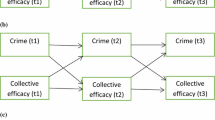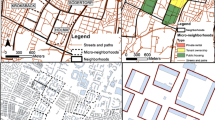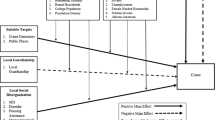Abstract
While much of the research on neighborhood crime considers the neighborhood as a whole, this study utilizes spatial analysis techniques to examine how the presence of disorder and collective efficacy create unique pockets of opportunities for criminal behavior within neighborhoods. This spatial perspective reveals how the effect of disorder and efficacy upon crime patterns itself varies across a neighborhood. Physical disorder is measured through systematic social observations and the level of collective efficacy is evaluated through survey responses of neighborhood residents. The indices of disorder and efficacy are compared to crime data from police call logs using geographically weighted regression. Our findings demonstrate a complex spatial relationship between disorder and efficacy. The effects of disorder and efficacy are not consistent across an entire neighborhood, but rather display local variations in small geographical areas within neighborhoods, including some pockets of the neighborhood where the relationships between disorder, efficacy, and crime were contrary to the expected relationships. Based upon these findings, we conclude opportunity is central to understanding crime, and emphasize the role of informal social control in neighborhoods.





Similar content being viewed by others
References
Braga, A. A., Weisburd, D. L., Waring, E. J., Mazerolle, L. G., Spelman, W., & Gajewski, F. (1999). Problem-oriented policing in violent crime places: A randomized controlled experiment. Criminology, 37(3), 541–580.
Brunsdon, C., Fotheringham, S., & Charlton, M. (1998). Geographically weighted regression-modeling spatial non-stationarity. The Statistician, 47(3), 431–443.
US Census Bureau (2010). 2010 census interactive population map. http://2010.census.gov/2010census/popmap/. Last Accessed 28 June 2012.
Bursik, R. J. (1988). Social disorganization and theories of crime and delinquency: Problems and prospects. Criminology, 26(4), 519–552.
Bursik, R. J., & Grasmick, H. G. (1993). Neighborhoods and crime: The dimensions of effective community control. Lanham: Lexington Books.
Cohen, L., Kluegel, J., & Land, K. (1981). Social inequality and predatory criminal victimization: An exposition and test of a formal theory. American Sociological Review, 46(5), 505–524.
Conley, J., Stein, R. E., & Davis, C. (2014). A spatial analysis of the neighborhood scale of residential perceptions of physical disorder. Applied Spatial Analysis and Policy, 7(2), 183–201.
Doran, B., & Lees, B. (2005). Investigating the spatiotemporal links between disorder, crime, and the fear of crime. The Professional Geographer, 57(1), 1–12.
Gorman, D. M., Gruenewald, P. J., & Waller, L. A. (2013). Linking places to problems: Geospatial theories of neighborhoods, alcohol and crime. GeoJournal, 78(3), 417–428.
Janowitz, M. (1975). Sociological theory and social control. American Journal of Sociology, 81(1), 82–108.
Kearns, A., & Parkinson, M. (2001). The significance of neighborhood. Urban Studies, 38(12), 2103–2110.
Kelling, G. L., & Coles, C. M. (1996). Fixing broken windows: Restoring order and reducing crime in our communities. New York: Touchstone.
Kornhauser, R. R. (1978). Social sources of delinquency: An appraisal of analytic models. Chicago: University of Chicago Press.
McCord, E., Ratcliffe, J., Garcia, R., & Taylor, R. (2007). Nonresidential crime attractors and generators elevate perceived neighborhood crime and incivilities. Journal of Research in Crime and Delinquency, 44(3), 295–320.
Morenoff, J. D., Sampson, R. J., & Raudenbush, S. W. (2001). Neighborhood inequality, collective efficacy, and the spatial dynamics of urban violence. Criminology, 39(3), 517–559.
Murray, A. T., McGuffog, I., Western, J. S., & Mullins, P. (2001). Exploratory spatial data analysis techniques for examinine urban crime. British Journal of Criminology, 41(2), 309–329.
Nolan, J., Conti, N., & McDevitt, J. (2004). Situational policing: Neighbourhood development and crime control. Policing & Society, 14(2), 99–117.
Nolan, J., Althouse, R., Stein, R. E., & Bennett, S. Situational policing. Washington, DC: Office of Community Oriented Policing Services, U.S. Department of Justice (in press).
Novak, K., & Seiler, C. (2001). Zoning practices and neighborhood physical disorder. Criminal Justice Policy Review, 12(2), 140–163.
Propper, C., Jones, K., Bolster, A., Burgess, S., Johnston, R., & Sarker, R. (2005). Local neighbourhood and mental health: Evidence from the UK. Social Science and Medicine, 61(10), 2065–2083.
Raudenbush, S. W., & Sampson, R. J. (1999). Ecometrics: Toward a science of assessing ecological settings, with application to the systematic social observation of neighborhoods. Sociological Methodology, 29(1), 1–41.
Sampson, R. J., & Groves, W. B. (1989). Community structure and crime: Testing social disorganization theory. American Journal of Sociology, 94(4), 774–802.
Sampson, R. J., & Raudenbush, S. W. (1999). Systematic social observation of public spaces: A new look at disorder in urban neighborhoods. The American Journal of Sociology, 105(3), 603–651.
Sampson, R. J., & Raudenbush, S. W. (2004). Seeing disorder: Neighborhood stigma and the social construction of ‘broken windows’. Social Psychology Quarterly, 67(4), 319–342.
Sampson, R. J., Raudenbush, S. W., & Earls, F. (1997). Neighborhoods and violent crime: A multilevel level study of collective efficacy. Science, 277(5328), 918–924.
Skogan, W. (1990). Disorder and decline: Crime and the spiral of decay in American neighborhoods. Berkeley, CA: University of California Press.
St. Jean, P. K. (2007). Pockets of crime: broken windows, collective efficacy, and the criminal point of view. Chicago: The University of Chicago Press.
Taylor, J., Twigg, L., & Mohan, J. (2010). Investigating perceptions of antisocial behavior and neighbourhood ethnic heterogeneity in the British crime survey. Transactions of the Institute of British Geographers, 35(1), 59–75.
Weisburd, D., Morris, N. A., & Groff, E. R. (2009). Hot spots of juvenile crime: A longitudinal study of arrest incidents at street segments in Seattle, Washington. Journal of Quantitative Criminology, 25(4), 443–467.
Wilson, J. Q., & Kelling, G. L. (1982). The police and neighborhood safety: Broken windows. Atlantic, 127, 29–38.
Wilson, J. Q., & Kelling, G. L. (2006). A quarter century of broken windows. The American Interest, 2(1), 168–172.
Xu, Y., Fiedler, M. L., & Flaming, K. H. (2005). Discovering the impact of community policing: The broken windows thesis, collective efficacy, and citizens’ judgment. Journal of Research in Crime and Delinquency, 42(2), 147–186.
Yang, S. M. (2010). Assessing the spatial-temporal relationship between disorder and violence. Journal of Quantitative Criminology, 26(1), 139–163.
Zhang, H., & Song, W. (2014). Addressing issues of spatial spillover effects and non-stationarity in analysis of residential burglary crime. GeoJournal, 79(1), 89–102.
Author information
Authors and Affiliations
Corresponding author
Rights and permissions
About this article
Cite this article
E. Stein, R., Conley, J.F. & Davis, C. The differential impact of physical disorder and collective efficacy: a geographically weighted regression on violent crime. GeoJournal 81, 351–365 (2016). https://doi.org/10.1007/s10708-015-9626-6
Published:
Issue Date:
DOI: https://doi.org/10.1007/s10708-015-9626-6




